2. Visit a forest. Here is a list of points that would make your visit more fruitful.
(a) Make sure that you have permission to go into the forest.
(b) Make sure that you can find your way around. Get a map and go along with someone who is familiar with the area.
(c) Keep a record of the things you see and do. Observations make the visit interesting. Sketches and photographs are useful.
(d) You may record bird calls.
(e) Collect different kinds of seeds or hard fruits like nuts.
(f) Try to recognise various types of trees, shrubs, herbs etc. Make lists of plants from different places in the forest and of different layers. You may not be able to name all the plants, but it is worth recording and seeing where they grow. Make a record of the approximate heights of plants, crown shape, bark texture, leaf size, and flower colour.
(g) Learn to recognise the animals’ droppings.
(h) Interview the forest officials and the people of surrounding villages and other visitors.
Answers:
(a) Make sure that you have permission to go into the forest.
To enter a forest in India it is advisable that you apply for permission from the relevant Forest Department depending on the location and the type of forest. To comply with legal requirements it is necessary to contact the concerned Forest Department and visit their website to learn about specific procedures, permissions, associated fees etc. It is essential to follow the guidelines properly to ensure preservation of the forest and its wildlife and also for your own safety.
(b) Make sure that you can find your way around. Get a map and go along with someone who is familiar with the area.
It is advisable that you visit the forest with an experienced guide or tour operator. They will help you navigate the forest and you can also ask them relevant questions for this activity and other insights.
(c) Keep a record of the things you see and do. Observations make the visit interesting. Sketches and photographs are useful.
We went to a Himalayan mountain forest and saw beautiful sceneries early in the morning and from high altitudes. We lodged in a tourist cabin by the forest and the tour guide pointed out some wildlife inside the forest the next morning! Some wonderful pictures from our visit are shown below:
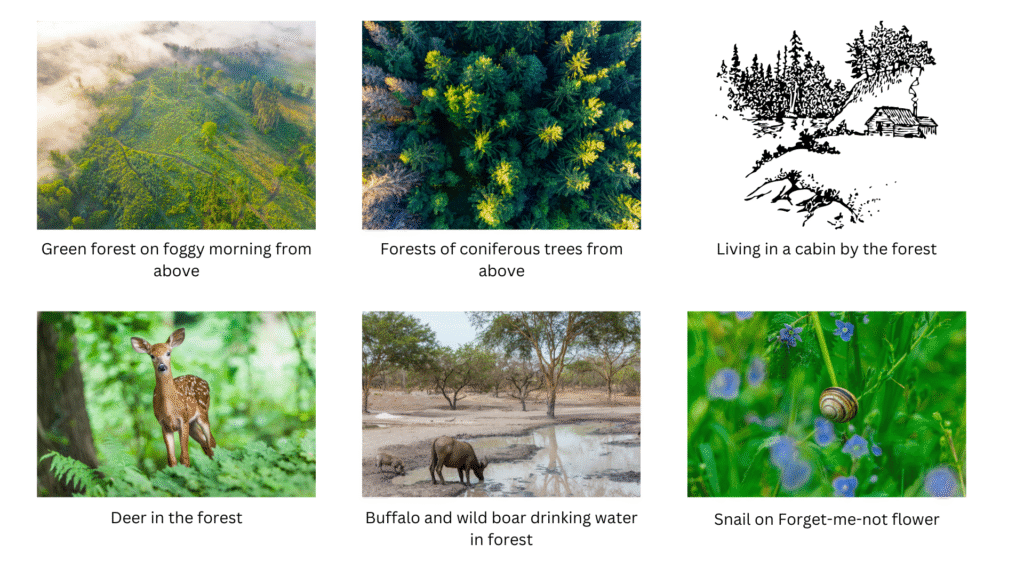
(d) You may record bird calls.
A recording showing a couple of Himayalan Bulbuls taking a bath inside the forest and calling loudly is shown below:
(e) Collect different kinds of seeds or hard fruits like nuts.
We collected pine cones, oak seeds and moss seeds and also nuts like walnuts and hazelnuts.
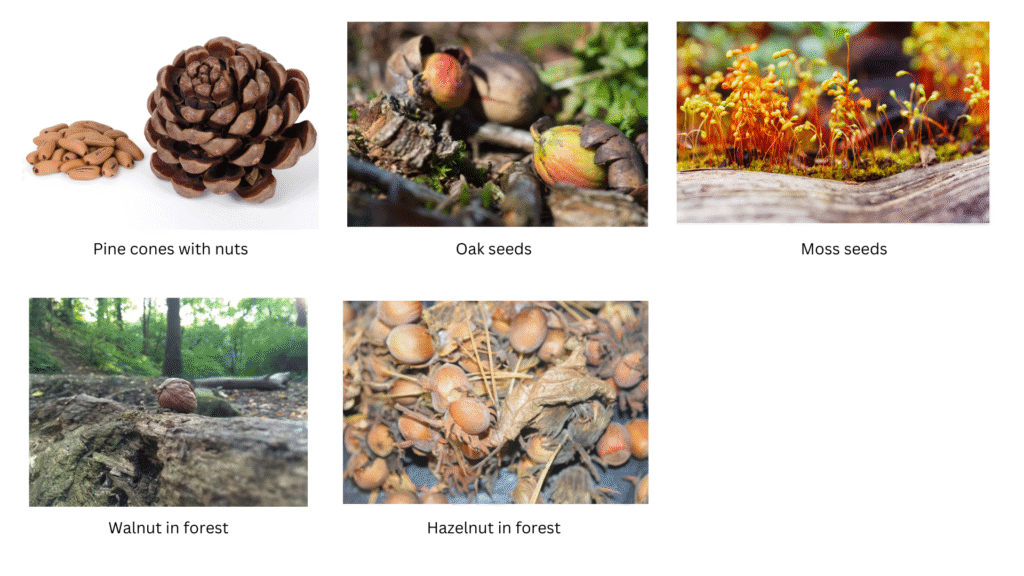
(f) Try to recognise various types of trees, shrubs, herbs etc. Make lists of plants from different places in the forest and of different layers. You may not be able to name all the plants, but it is worth recording and seeing where they grow. Make a record of the approximate heights of plants, crown shape, bark texture, leaf size, and flower colour.
The details of the trees, shrubs, herbs etc which we recognised are shown below:
Trees forming the top layer:
We identified the following trees: Pine, oak and redwood. Find the pictures below:

Pine Tree:
Approximate Height: 60 – 90 feet
Crown Shape: Conical or pyramid shape
Bark Texture: Rough and scaly
Leaf Size: 9 – 16 inches
Flower Colour: Mature pine cones are dark brown in colour.
Oak Tree
Approximate Height: 50 – 60 feet
Crown Shape: Broad and rounded
Bark Texture: Rough and furrowed
Leaf Size: 2 – 8 inches
Flower Colour: Yellowish
Redwood Tree
Approximate Height: 200 – 300 feet
Crown Shape: Conical or plume shaped
Bark Texture: Rough and furrowed
Leaf Size: 0.4 – 1 inch
Flower Colour: Cones are brown in colour
Shrubs forming the second layer:
We identified the following shrubs: Bougainvillea, rhododendron and hydrangea. Find the pictures below:

Bougainvillea Shrub
Approximate Height: 10 – 20 feet
Crown Shape: Irregular or rounded
Bark Texture: Smooth and thin
Leaf Size: 2 – 5 inches
Flower Colour: Pink, purple, red, yellow, and white
Rhododendron Shrub
Approximate Height: 3 – 9 feet
Crown Shape: Rounded or dome-shaped
Bark Texture: Ranges from smooth to fissured
Leaf Size: 2 – 6 inches
Flower Colour: White, red, pink, yellow, blue, magenta
Hydrangea Shrub
Approximate Height: 3 – 6 feet tall
Crown Shape: Rounded or dome-shaped
Bark Texture: Smooth
Leaf Size: 2 – 4 inches
Flower Colour: Blue, red, pink
Herbs forming the lowest layer:
We identified the following herbs: Tulsi and Sweet basil. Find the pictures below:
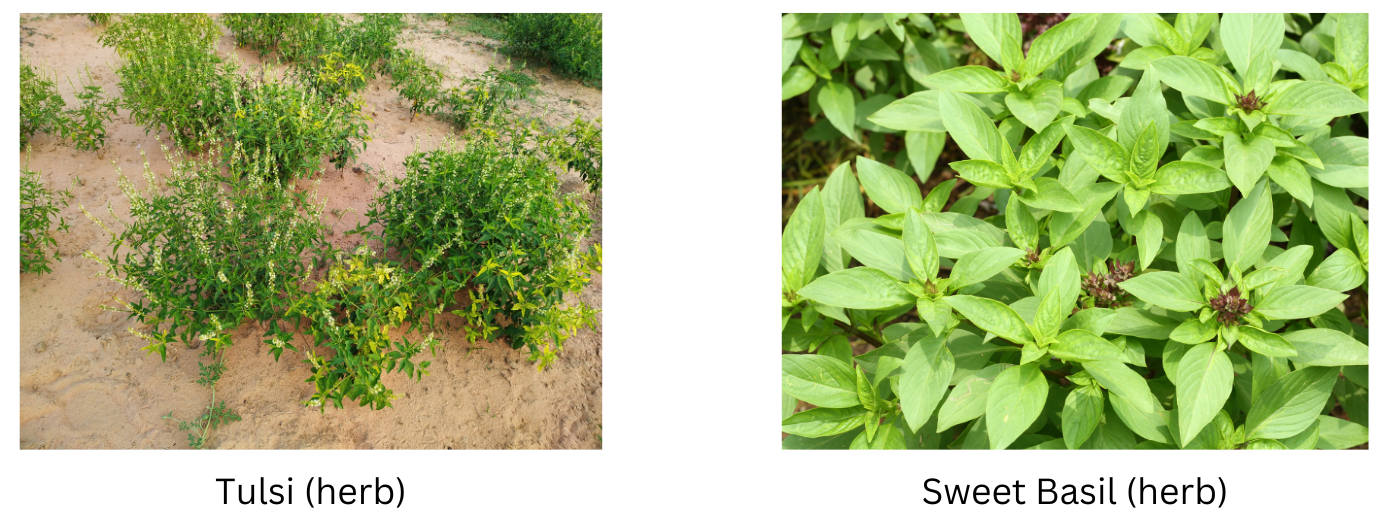
Tulsi
Approximate Height: 1 – 3 feet
Crown Shape: Bushy and rounded
Bark Texture: Smooth
Leaf Size: 1 – 2 inches
Flower Colour: Purple or white
Sweet Basil
Approximate Height: 1 – 2 feet
Crown Shape: Bushy and rounded
Bark Texture: Smooth
Leaf Size: 1 – 4 inches
Flower Colour: White or purple
(g) Learn to recognise the animals’ droppings.
You can identify the type of animals from the shape and contents of the animal’s faeces. Images of droppings of some common animals are given below along with the description:
Rabbit Droppings: Rabbit droppings consists of small pea-sized pellets (as shown below) and are black, dark brown or green in colour. They consist of small undigested pieces of plant and grass and can thus be easily identified.
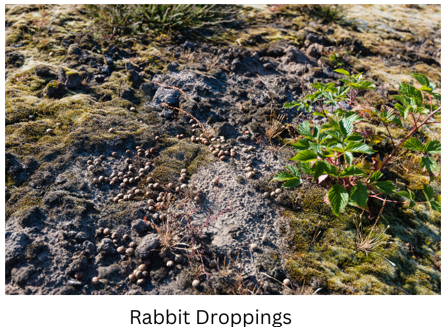
Buffalo Dung: Buffalo dung appears in large round heaps and are mostly brown or grey in colour. The faeces contain undigested grass which the animal frequently feeds on. You can use these clues to easily identify buffalo dung if required.
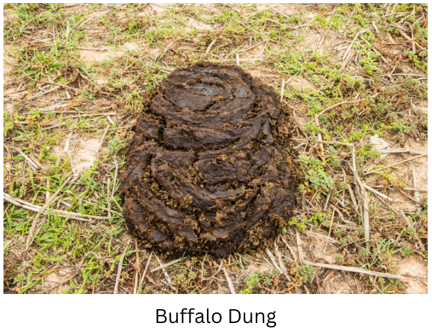
Deer Dung: Deer dung consists of dark and round pellets much like rabbit dung. However, they can be distinguished by their smooth and shiny texture and the absence of grass or other contents in the droppings. Deer dung also sticks together in clusters as shown below:
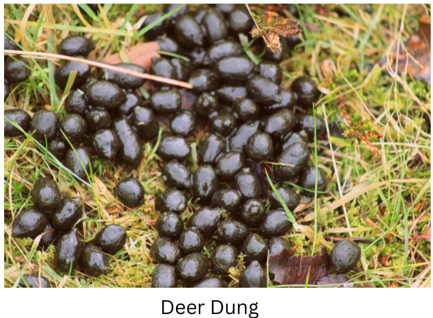
(h) Interview the forest officials and the people of surrounding villages and other visitors.
I approached a forest official with some critical questions during out visit. Here is how the interview went:
Interview With Forest Official
Me: Why is this forest important?
Forest Official: The forest is essential for maintaining the ecological balance of the area. It provides habitats for many species of flora and fauna. The forest brings sufficient rainfall and helps to replenish groundwater levels for drinking and irrigation purposes. It also helps to purify the air by continuously releasing oxygen. In short, the forest is full of life and vitality. For these reasons forests should be preserved and nurtured. It is vital that nature is not disturbed.
Me: What is your role in managing and protecting the forest?
Forest Official: We have strict regulations along with continuous surveillance by forest rangers to prevent illegal logging and poaching. We also frequently engage in reforestation efforts and educate the local community about the dangers of deforestation.
Me: What is one challenge that came up recently?
Forest Official: One big challenge that we dealt with recently was illegal encroachment in the form of small settlements on the outskirts of the forest. The problem was quickly resolved following our intervention.
Me: As a forest official, what advice do you have for school kids like us who are interested in forests and the environment? What are the key things you want us to know?
Forest Official: Appreciate the assets like forests that God has given us. As we talked about before, forests provide us with clean air and water and other resources. Educate yourself and your community on how to use these resources judiciously, recycle and reduce waste and participate in awareness campaigns and afforestation efforts. We are lucky to have young students like you interested in the matter as you are the future of our country!
Interview With People of Surrounding Villages
I also interviewed some people of the surrounding villages who were more than happy to interact with us. Here is the transcript of the interview:
Me: Do you go into the forest frequently? How does it help your livelihood?
Villager: Yes, we venture into the forest everyday to gather timber and for fishing. Our entire livelihood depends on it directly or indirectly. Tourists visit the surroundings areas and this contributes to the local economy. The forest also brings us fresh water in the form of rain.
Me: Do you know anything interesting about the forest?
Villager: Oh yes! We see many rare species of birds and insects during our daily travails. Also, the forest has provided us with rare medicinal herbs for generations. We use these in the food that we eat and also in medicines.
Me: Can you name any challenges that the forest has faced in recent times?
Villager: Yes, there was a conflict with forest authorities regarding cutting down a small part of the forest to allow for expansion of agricultural land. The Forest Department intervened and an alternative method to farming was decided upon, which quickly resolved the issue.
Me: How do you help preserve the forest?
Villager: We take part of afforestation efforts alongside the forest officials who share our passion for the forest and nature in general. We also educate our children on the importance of forest conservation so that we can breathe clean air and drink clean water for many generations to come
Interview With Other Visitors
There were many visitors and I was excited to interview them. Here is the dialogue between me and an adult visitor:
Me: Why did you visit this forest?
Visitor: I was attracted by the beautiful landscape, the wildlife and also to take a break from the polluted city and breathe fresh and clean air for some time. I also enjoy photography!
Me: Did you enjoy the forest?
Visitor: Of course! It was a welcome break from the hustle and bustle of the city. The cool, clean air was very calming and I took long walks with my tour guide, drinking in the tranquil beauty of the forest. I also took amazing pictures to show to my friends and family. Hopefully, it will inspire them to appreciate the beauty that nature has to offer.
Me: Have you learned anything interesting during your visit that made you think differently about the forest?
Visitor: Oh yes! Our tour guide told us about the alarming rate of deforestation worldwide and the harmful effects it has on the global climate, wildlife and even humanity. I vowed to participate in the global conservation efforts after learning about its importance. After all, what better place to start than our own country!
Me: Will you come back to visit the forest in the future?
Visitor: Yes, I definitely plan on coming back here and also plan to visit forests elsewhere during the next holiday. This visit was a huge eye opener for me and all in all, a wonderful experience!
“Visit a forest. Here is a list of points that would make your visit more fruitful.
(a) Make sure that you have permission to go into the forest.
(b) Make sure that you can find your way around. Get a map and go along with someone who is familiar with the area.
(c) Keep a record of the things you see and do. Observations make the visit interesting. Sketches and photographs are useful.
(d) You may record bird calls.
(e) Collect different kinds of seeds or hard fruits like nuts.
(f) Try to recognise various types of trees, shrubs, herbs etc. Make lists of plants from different places in the forest and of different layers. You may not be able to name all the plants, but it is worth recording and seeing where they grow. Make a record of the approximate heights of plants, crown shape, bark texture, leaf size, and flower colour.
(g) Learn to recognise the animals’ droppings.
(h) Interview the forest officials and the people of surrounding villages and other visitors.” – Solved.
Related Links:
Solution to Extended Learning Problem 1
Solution to Extended Learning Problem 2
Solution to Activity 12.1
Solution to Activity 12.2
Solution to Activity 12.3


